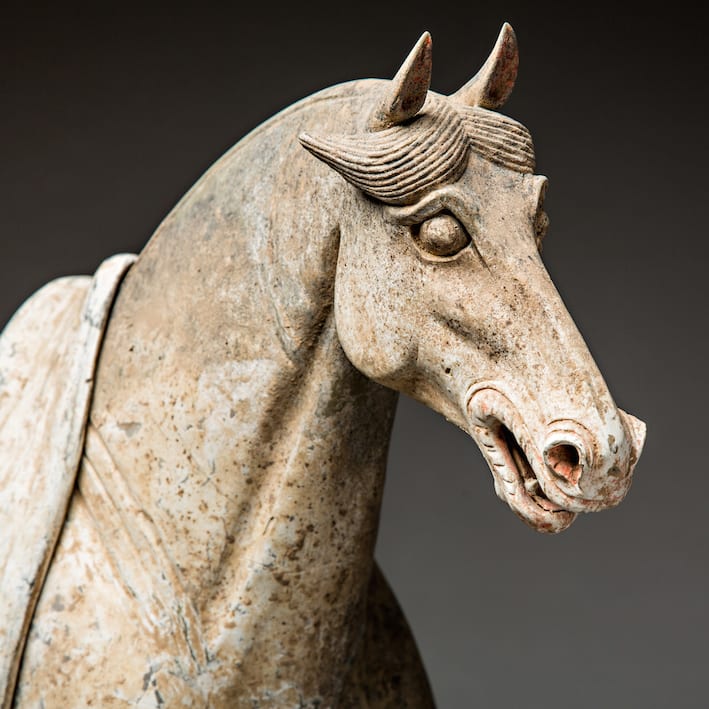Tang Sculpture of a Horse with Removable Saddle, 7th Century CE - 8th Century CE
Terracotta
66.7 x 64.1 cm
26 1/4 x 25 1/4 in
26 1/4 x 25 1/4 in
X.0424
Further images
The Tang Dynasty was a golden age of Chinese culture. The arts reached new levels of sophistication. Poetr and literature flourished under the enlightene rulership. The Silk Road brought fortunes...
The Tang Dynasty was a golden age of Chinese culture.
The arts reached new levels of sophistication. Poetr and literature flourished under the enlightene rulership. The Silk Road brought fortunes into Chin on the backs of camels, carrying exotic luxury item from distant lands. Foreign merchants from acros Central Asia and the Middle East settled in the urba centers of the Tang China, foremost among them th thriving capital of Chang’an (modern X’ian), bustling cosmopolitan centre of over two millio inhabitants. The Tang Dynasty was a relatively stabl period of great prosperity representing one of th greatest cultural flourishings in human history.
During the Tang Dynasty, the adoration of the hors can be seen through their burial art. Horse model excavated from mausoleums of the period are among th most splendid and easily recognizable works of Chines art.
The great influence of the horse throughout th history of China cannot be underestimated. In fact,
the ancient unification of the Chinese Empire was du in large part to the horse. Their rapid mobilit allowed for quick communication between far awa provinces. Likewise, the military role of horses aide in the conquest and submission of distant lands. Th need to import stronger, faster steeds from Centra Asia (as opposed to the native Mongol pony) led to th creation of the Silk Road. The importance of the hors in the history and culture of China can be viewed, i part, through the artistic legacy of this grea civilization. In sculpture, painting, and literature,
horses were glorified and revered, believed to b relatives of dragons, a theory reflecting their sacre status within society.
This impressive, large sculpture of a horse stil retains much of its original white pigment in tact.
However, even more impressive, is the removable saddl with engraved details that graces his back. Thi saddle appears to have once been painted orange an likely would have once supported a sculpted rider. Th horses ears stand at attention. Its striking eyes ar well defined. Its nostrils are flared and its mout is open, suggesting the horse has just come to res after a vigorous journey. These rare features, i particular the open mouth and removable saddle, ar highly sought after by collectors. This gorgeou sculpture is a testament to the admiration an adoration the Chinese had for this marvelous creature.
Although they were an integral part in the expansio and defense of the empire, they were equally regarde for their beauty and grace as revealed by thi sculpture.
The arts reached new levels of sophistication. Poetr and literature flourished under the enlightene rulership. The Silk Road brought fortunes into Chin on the backs of camels, carrying exotic luxury item from distant lands. Foreign merchants from acros Central Asia and the Middle East settled in the urba centers of the Tang China, foremost among them th thriving capital of Chang’an (modern X’ian), bustling cosmopolitan centre of over two millio inhabitants. The Tang Dynasty was a relatively stabl period of great prosperity representing one of th greatest cultural flourishings in human history.
During the Tang Dynasty, the adoration of the hors can be seen through their burial art. Horse model excavated from mausoleums of the period are among th most splendid and easily recognizable works of Chines art.
The great influence of the horse throughout th history of China cannot be underestimated. In fact,
the ancient unification of the Chinese Empire was du in large part to the horse. Their rapid mobilit allowed for quick communication between far awa provinces. Likewise, the military role of horses aide in the conquest and submission of distant lands. Th need to import stronger, faster steeds from Centra Asia (as opposed to the native Mongol pony) led to th creation of the Silk Road. The importance of the hors in the history and culture of China can be viewed, i part, through the artistic legacy of this grea civilization. In sculpture, painting, and literature,
horses were glorified and revered, believed to b relatives of dragons, a theory reflecting their sacre status within society.
This impressive, large sculpture of a horse stil retains much of its original white pigment in tact.
However, even more impressive, is the removable saddl with engraved details that graces his back. Thi saddle appears to have once been painted orange an likely would have once supported a sculpted rider. Th horses ears stand at attention. Its striking eyes ar well defined. Its nostrils are flared and its mout is open, suggesting the horse has just come to res after a vigorous journey. These rare features, i particular the open mouth and removable saddle, ar highly sought after by collectors. This gorgeou sculpture is a testament to the admiration an adoration the Chinese had for this marvelous creature.
Although they were an integral part in the expansio and defense of the empire, they were equally regarde for their beauty and grace as revealed by thi sculpture.







